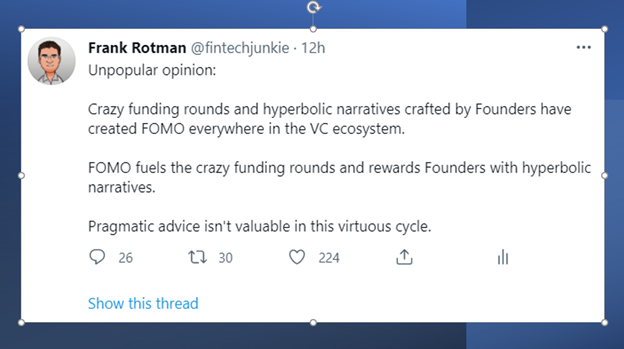
After months of hard work you’ve managed to raise a comfortable amount of new of capital for your #startup. Now what?
A simple thread for Founders and VCs about shifting from a “need to raise” to a “need to prove” mindset.
A simple thread for Founders and VCs about shifting from a “need to raise” to a “need to prove” mindset.

2/21: Preamble: Not all businesses are venture backable. If the size/outcome potential is too small then raising VC money and running a VC backed startup playbook might not make sense. This thread is meant as good, generic advice for early/mid stage VC backed businesses.
3/21: Venture investing is very simple at its core. VCs invest in Founders who are building businesses that solve big problems.
Every Founder’s pitch describes a large profound problem, their solution to the problem, and the financials the business will generate over time.
Every Founder’s pitch describes a large profound problem, their solution to the problem, and the financials the business will generate over time.
4/21: Getting the problem and solutions statements right is important. They’re what customers ultimately care about and define a startup’s reason d’etre.
But unless the solution can be delivered profitably at scale the business won’t survive. This is “sine qua non” for success.
But unless the solution can be delivered profitably at scale the business won’t survive. This is “sine qua non” for success.
5/21: But success isn’t a 0/1 switch. VCs understand that startups are built in stages and that great companies are built on top of good companies. They can fall in love with a startup’s vision, but eventually the numbers need to fall in place for a startup to be “great”.
6/21: So while a well-crafted narrative can convince a VC to write a super early-stage check, disciplined early/mid stage VCs strive to make decisions based on answering the question: “How quickly and how much can a startup learn for how much money?”
7/21: When a startup puts money to work it gains insight into the business’s underlying assumptions.
Positive results: Progress has been made towards de-risking the outcome.
Negative results: At best the business is no closer to de-risking the outcome.
Positive results: Progress has been made towards de-risking the outcome.
Negative results: At best the business is no closer to de-risking the outcome.
8/21: Building a startup is about turning over cards and hoping for positive proof that the business is on track.
But while VC investing is about analyzing cards as they’re turned over, being a Founder is about lining up the cards and determining the order they’re turned over.
But while VC investing is about analyzing cards as they’re turned over, being a Founder is about lining up the cards and determining the order they’re turned over.
9/21: The beauty of completing a fundraise is that a startup’s runway has been extended which allows a Founder to turn his/her attention to de-risking the business by turning over more cards.
https://twitter.com/fintechjunkie/status/1326152329943539713?s=20
10/21: A startup’s learning agenda should turn over enough cards that the startup is “materially different” when the next fundraise begins. Proving out critical assumptions and scaling is important. Filling in competency/people gaps is essential.
https://twitter.com/fintechjunkie/status/1386060625407848448?s=20
11/21: @SahilBloom talks about inversion focused problem-solving skills in an amazingly constructed thread. Startups should focus on what they want to look like before their next raise and work backwards from this goal.
https://twitter.com/SahilBloom/status/1416764190136614912?s=20
12/21: So while there’s no perfect playbook for constructing a learning agenda, what follows are a few questions that a Founder should be asking about their business before locking one in. The list is illustrative but by no means complete:
13/21: Proof that customers want your product
Is it easy to find and close new customers?
💥Are your customers engaging with your product the way you want them to?
💥Is attrition low/retention high?
💥Is organic traffic/referrals a major contributor to growth?
Is it easy to find and close new customers?
💥Are your customers engaging with your product the way you want them to?
💥Is attrition low/retention high?
💥Is organic traffic/referrals a major contributor to growth?
14/21: Proof that you can scale
💥Is CAC staying steady as you increase your origination volume?
💥Are you able to originate new customers in multiple, deep channels?
💥Have you built a proprietary originations channel and if so, how deep is it?
💥Is CAC staying steady as you increase your origination volume?
💥Are you able to originate new customers in multiple, deep channels?
💥Have you built a proprietary originations channel and if so, how deep is it?
15/21: Proof that customers are profitable
💥Are contribution margins positive?
💥Are payback periods within an acceptable range?
💥Are the unit economics of each vintage improving over time?
💥Are contribution margins positive?
💥Are payback periods within an acceptable range?
💥Are the unit economics of each vintage improving over time?
16/21: Proof that business level profitability is possible
💥Is overhead as % of revenue declining?
💥Is the burn rate monotonically decreasing as the business scales?
💥Is there line of sight to in-period profitability if “new investments” were shut off?
💥Is overhead as % of revenue declining?
💥Is the burn rate monotonically decreasing as the business scales?
💥Is there line of sight to in-period profitability if “new investments” were shut off?
17/21: Proof of additional contribution margin
💥Are existing customers willing to buy additional products?
💥Can price be increased in a profitable fashion?
💥Can 3rd party contracts be renegotiated to improve margins?
💥Can automation drive efficiency and reduce cost?
💥Are existing customers willing to buy additional products?
💥Can price be increased in a profitable fashion?
💥Can 3rd party contracts be renegotiated to improve margins?
💥Can automation drive efficiency and reduce cost?
18/21: Proof that you can attract talent
💥Is the team happy and does talent stick around?
💥How quickly can you fill open positions with top-tier hires?
💥Are there employee complaints/lawsuits?
💥Have heavy hitters been recruited to expand the Executive ranks/capabilities?
💥Is the team happy and does talent stick around?
💥How quickly can you fill open positions with top-tier hires?
💥Are there employee complaints/lawsuits?
💥Have heavy hitters been recruited to expand the Executive ranks/capabilities?
19/21: Proof of operational discipline
💥Is the team able to hit their OKRs?
💥Has the team been able to obtain necessary licenses and negotiate good 3rd party contracts?
💥Are operational mistakes and complaints/lawsuits handled quickly and with minimal collateral damage?
💥Is the team able to hit their OKRs?
💥Has the team been able to obtain necessary licenses and negotiate good 3rd party contracts?
💥Are operational mistakes and complaints/lawsuits handled quickly and with minimal collateral damage?
20/21: The above is a merely a sampling of the questions that a Founder could ask when setting a learning agenda. But unfortunately learning takes time and effort and spreading resources too thin is the best plan for showing up to your next fundraise with half-finished homework.
21/21: So, if you’re building a startup, the best time to take stock of what you’ve learned and what you still have to prove is immediately after raising capital. It’s important to shift from “need to raise” into “need to prove” mode so do it the day after a raise is completed!
• • •
Missing some Tweet in this thread? You can try to
force a refresh










